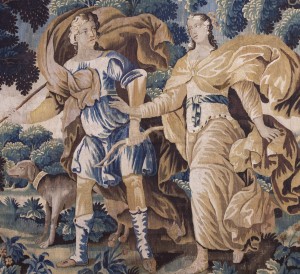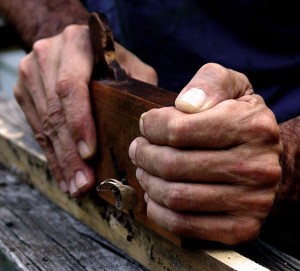Strange World of the Bible: Nudity, Public ‘Bathing,’ and Dogs
Author: Bobby Valentine | Filed under: Bible, Culture, Exegesis, Hermeneutics, Jesus, Jewish Backgrounds, Matthew
A rich and wonderfully detailed book about nitty gritty of the very dirty world of first century Palestine
I recently wrote about the “distance” between the biblical text and modern North American disciples in my blog: Evel Knievel, the Grand Canyon & Us: The Strange and Deep Gulf to the Bible. That blog has inspired me to post every weekend a shorter blog to called “Text and Context: Strange World of Scripture” in honor of K. C. Moser. Moser was brought on the staff of the Gospel Advocate for a short time by Foy Wallace Jr but was removed become of the deteriorating relationship between Wallace and Moser. But Moser’s column was called “Text and Context.” I want to highlight as briefly as possible things that are often literally hidden in plain view but simply are filtered out of our consciences when we read the Bible through our modern, post-Enlightenment, Western, American, Victorian Eyes (how’s that for a line 😉 )
Today I offer a short paragraph on five little items that can help us both recognize the cultural gap between us and the text and enlighten and even delight us as we immerse ourselves in the written word that is so enmeshed with the particularity of its point of origin in time.
PG-13 …
We, modern western disciples, are often oblivious to the massive historical and cultural gulf between the New Testament and “us.” As archeologist Jodi Magness noted “Westerners tend to view the ancient world through a highly sanitized lens.” This gulf that exists frequently blinds us to things the NT writers even state point blank.
One of the “gulfs” is that of public nudity. Male nudity was not an uncommon reality in Palestine. Men working in the heat of the day in the fields or even fishing were known to be “naked.” Numerous Jewish texts corroborate this reality. Just one example with the disciples takes place in John 21.7 where the disciples are fishing. “When Simon Peter heard that it was the Lord, he put on some clothes, for he was naked, and jumped into the sea.”
This kind of nudity was quite different than the stripping of the criminal. Jesus was equally nude but this was a Roman attempt at shaming … Melito of Sardis related, “The Master has been treated in unseemly fashion, his body naked, and not even deemed worthy of a covering that his nakedness might not be seen. Therefore the lights [of heaven] turned away, and the day darkened, that it might hide him who was stripped upon the cross.”
Purity or Why We Get Wet
When we read the Gospels within their Social Context, we are quite surprised by the absence of some issues that we would expect if the common evangelical vision of Jesus is accurate. The issue of “purity” was a crucial one in Judaism of Jesus’ day. There are over 700 ancient miqva’ot – most dating before AD 70, spread over Judea and Galilee. A miqva’ot is a pool in which Jews would immerse themselves to become ritually clean. They are basically Jewish baptisteries. The presence of these miqva’ot, btw, also explains why (historically) no one ever argued about baptism in Palestine because ritual immersion was universally regarded by Jews as necessary for purification in Judaism. Such a miqva’ot is the site of Jesus healing the blind man in John 9.
In the Gospels we read of conflict over the Sabbath, and hand washing, but we do not read of any conflict on this matter of purity in general. Jesus HAD to observe the purity laws to enter into the temple. Putting a mental picture of Jesus, Peter, John and Paul purifying – immersing – themselves in our head can do amazing things as we read the text. Nor do we read anywhere of an accusation of Jesus eating unclean food which is astounding. Failure to “baptize” the hands, however is rejected by Jesus because that is something the Torah itself did not require. The more you place Jesus in his context the more Jewish he becomes. Many times we moderns are more with the Pharisees than Jesus in demanding MORE than the Torah actually says.
Lassie
Jesus said “do not give what is holy to dogs” (Mt 7.6). Dogs in Palestine in biblical times were not the animals that Americans practically worship spending millions of dollars on each year. In the text just quoted in Mt 7.6, dogs are intimately associated with the unclean pig. Dogs in that culture were pack animals that scavenge for a living. The Proverbs present the common low opinion of dogs, “Like a dog that returns to its vomit is a fool who reverts to his folly.” (Prov. 26:11).
In the social context of Mt 7.6 the “holy things” are almost certainly dedicated meat from sacrificial meals. Jesus’ own words, like the good rabbi he was, echo the Torah, “You shall be a holy people to me; therefore you shall not eat any meat that is mangled by beasts of the field; you shall throw it to the dogs” (Ex 22.31). Unclean meat is only good for the “dogs.” But clean food do not give to the dogs. This ends up having an ethical/moral dimension to it. People who are unholy should not be given that which belongs to God. I know of only one positive reference to a dog in all of biblical literature and that is in the book of Tobit. When Tobias heads out on his journey to Rages he takes the family dog (Tobit 6.2; 11.4). This does not mean that God does not like Sebastian though 🙂
Illustration from Women’s World
In Matthew 5.14-16 we hear Jesus say “You are the light of the world. A city built on a hill cannot be hid. No one after lighting a lamp puts it under the bushel basket, but on a lamp stand …” In this text Jesus makes two cultural allusions. One is a traditional biblical image and the other a social convention. Israel, in Jewish tradition, had been placed in the world by God to be the “light of the world.” And Jesus speaks in a way that engages even women in his day. The lighting of lamps in the home was a “woman’s job” in Jesus day. So even men can learn and be exhorted by the example of women. Jesus uses “women’s'” work in a positive way indicating he intended intended both a male and female audience.
Carpenter Is not an Insult
I remember thinking at one time that the Gospels indicated that Jesus was a Carpenter because of his lowly position. This was a false understanding and one of those “gulfs” in our culture. Almost all early rabbis had some kind of job. Paul was a tent-maker (and Paul was certainly a rabbi). One of the most famous rabbis of all, Hillel was a “Wood Chopper.” His equally famous contemporary, Shammai was a “Builder.” Rabbi Joshua was a black smith. Rabbi Abba Hoshaiah was a “laundryman.” Rabbi Oshaya was a “shoemaker.” Rabbi Abin Naggara was known, like Jesus of Nazareth, as “the carpenter. The Gospels in identifying Jesus as a carpenter are not emphasizing his poverty or his lowliness. Rather this shows that he was a legitimate rabbi.
Think about Yeshua today. He was born a Jew. He lived as a Jew. He taught as a Jew. He was crucified as a Jewish troubler … God raised him as a Jew … to be the Messiah of Israel and Lord of all.



April 3rd, 2016 at 3:22 pm
Our Palestinian Christian guide to the Holly Land insisted the Jesus was a TEKNON meaning a “builder” (which included, primarily, stone mason. He probably worked primarily Sephora. What do you think.
April 3rd, 2016 at 4:04 pm
Dr Mitchell certainly glad to have you read and comment on my blog. It is certainly possible that Jesus was more of what we might think of as a stone mason than a carpenter as we westerners think of them. Sepphoris was a massive construction project for the better part of Jesus’s life and would have been an easy place for Joseph, Jesus and the brothers to have a source of employment. I have actually read some arguments that go both ways on the wood working and stone working. Have you ever read Richard Batey’s book “Jesus and the Forgotten City” in which he argues that Sepphoris was a natural place for Jesus to have worked and the culture there shaped his teaching and preaching. He argues that Jesus was a stone worker (most likely). I tend to lean to the position that Jesus was a “hard worker” 😉
Jesus and the Forgotten City: New Light on Sepphoris and the Urban World of Jesus
April 4th, 2016 at 6:59 am
Carpenters today make pretty good money if they are good carpenters. During Jesus time I am sure this was also the case, that is if they worked for those who paid the big money. Joseph was never called a rabbi and at one point in time Joseph is entirely seemingly absent from Jesus and his family’s life, as Mary was to be taken in by one who was not her family.
And yet this was still blue collar work and far from the status that many expected Jesus to come in the form of or from. They expected a lineage of a high standing to high standing to the savior.
April 4th, 2016 at 2:54 pm
Oh yeah, Is nudity always nudity? From what I understand one could be naked and not be completely naked as in one having a loin cloth on. Sometimes the word naked is accompanied by bare or without clothing, so is their the possibility that naked in some instances could include clothing.
Either way it seems as though it is a shameful state to be in according to the scriptures.
February 8th, 2018 at 6:20 am
I note that this blog is from 2016 but since Bobby referenced it today I’d ask about nudity and circumcision. We had open showers in our HS gym locker room but since that time only my wife and a doctor or 2 would know whether I was a Jew or a Gentile! But that apparently was not such a secret in bible times.